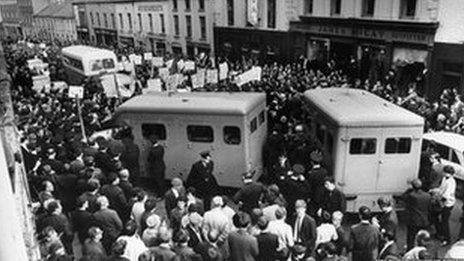Exhibition marks 50 years of Free Derry Corner
- Published
Liam Hillen was the person who wrote on the Free Derry wall back in 1969.
It was a night of high emotion at the end of a day of turmoil.
The late 1960s was a time of civil rights and civil unrest in Northern Ireland.
A group of young men gathered on a street corner in the Bogside area of Londonderry; a paint pot and brush were produced.
On a gable wall of a house on Lecky Road, they daubed the words: "You are now entering Free Derry."
It was 5 January 1969.
Half a century on and that Bogside terraced row may be no more, but the iconic wall and landmark slogan remain.
Now sited in the heart of the Bogside, Free Derry Corner stands as a reminder of a troubled past and a symbol of the demand for change. It has become one of Derry's most visited tourist attractions.
A new exhibition chronicling its origins, history and modern-day significance has opened in the Museum of Free Derry.
Gang attack
The last year of the sixties had begun in the same vein as the previous year had ended.

The People's Democracy campaigners marched from Belfast to Derry in early January 1969
Civil rights campaigners in Northern Ireland clamoured for equal voting rights, an end to gerrymandering and discrimination.
On 4 January, a People's Democracy-led civil rights march from Belfast to Derry was attacked by gangs of loyalists at Burntollet Bridge.
The attack sparked rioting in Derry's city centre and Bogside.
As the Royal Ulster Constabulary - the then police force - withdrew from the area, day turned to night.
Veteran civil rights campaigner Eamonn McCann was among the group at the corner of Lecky Road.
The events of the day "had sent a tremor of nervousness though the area", he said.

What became known as Free Derry Corner became an unofficial gathering point for people in the Bogside
The gathering discussed what to do next.
It was decided a slogan was needed.
Not for the first time in the civil rights era, inspiration was drawn from the protest movement across the Atlantic.
"I had seen the placard from Berkeley College in California which students had occupied and a sign outside it saying 'you are now entering free Berkeley' - that came back to me that night," said Mr McCann.
Also among those assembled at the gable end was local man Liam Hillen.
"Liam went off and got a pot of paint and inscribed it on the wall. It wasn't painted like a professional, Liam wasn't a professional painter.
"It is part of why Derry is known. Liam Hillen did that by scrawling that on the wall in the Bogside.
"The fact that it is still standing, and become so well known around the world, that never occurred to any of us at the time."

The row of terraced houses was demolished but the wall was preserved
The wall's original artist died on Christmas Day, at the age of 69. The Hillen family say they are proud of his legacy.
His brother Charlie Hillen told BBC Radio Foyle: "If you went to the back hills of Australia or America and say 'Free Derry Corner', people would probably know what you are talking about.
"There is always a crowd gathering there and I feel like going over and saying: 'That was my brother.'"
In the months that followed, the slogan was rebranded and painted over with the more recognisable font and design that endures.

This slogan was first painted on a Londonderry gable wall in January 1969 by local man Liam Hillen
As the Bogside area was developed, the terraced row was demolished to make way for a new road.
The gable end was preserved.
"That was an early sign of the significance of the wall," says Museum of Free Derry manager Adrian Kerr.
"The redevelopment occurred around Free Derry Corner, not through it."

The gable wall now stands in the heart of Derry's Bogside
During the 50 years since the slogan first appeared, he says the wall had endured and was recognised as a symbol of civil rights and of struggle, both locally and internationally.
"It started off as a symbol of civil rights in the 1960s," said Mr Kerr. "Then the demand was for one-man one-vote, decent jobs and housing.
"The conflict here brought a range of different issues, political and prison issues and the wall was also central to republican electioneering."
He said when the Troubles in Northern Ireland ended with the signing of the Good Friday Agreement, new issues began to be highlighted at Free Derry Corner.

Free Derry Corner was one of a number of landmarks turned pink for Organ Donation Week in 2018
"By the 1990s there were billboards relating to issues such as AIDS awareness," he says.
"We've had gay rights, women's rights, traveller's issues, international issues like Catalonia and Palestine all highlighted on the wall.
"It is there as a site, a place, a symbol, to promote civil rights now as much as it was in 1969 when it was first painted."
- Published30 September 2018

- Published7 October 2018

- Published6 May 2018

- Published20 February 2017
